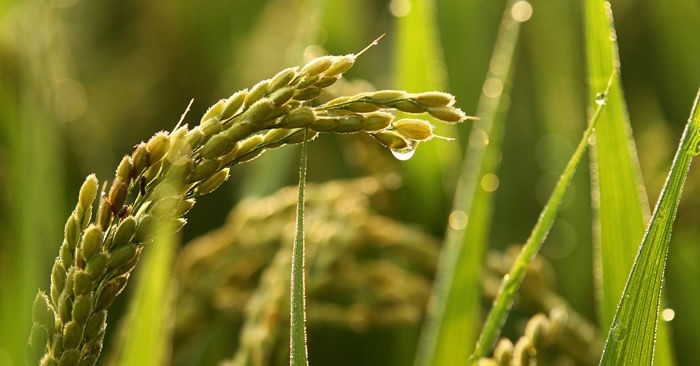
File Photo[/caption] The Green Super Rice (GSR) breeding strategy was started at IRRI in 2008 to efficiently develop lines with versatile stress tolerance and more nutritional- and water-use efficiency with high genetic gain for various targeted ecosystems. Development of improved rice varieties with GSR breeding methods under fertilizer, pesticide, and irrigation water depletion rates, grown in marginal environments and producing low greenhouse gas emissions and with improved grain nutrients. The goal of GSR breeding is to develop stable high-yielding GSR rice varieties with green characteristics suitable for growing in low input conditions in irrigated and rainfed areas of Asian and African countries. Multiple abiotic stresses greatly influence crop productivity and have adverse effects on plant growth and development. For example, drought is a major constraint in rice production and approximately 42 million hectares of rice in Asia suffer significant yield losses from varying amounts of drought stress at the different crop growth stages. Besides drought, soil salinity and alkalinity are also devastating factors that cause significant yield losses of rice crops at the vegetative and reproductive stages. Globally, about 20% of the cultivable land and 33% of irrigated agricultural areas are afflicted by salinity stress. Thus, it is crucial to identify stress-tolerant rice varieties to maintain productivity and meet global food security needs. Beyond abiotic stresses, sustainable rice production has become one of the top priorities in developing and adopting eco-friendly rice varieties with low input-use efficiency. In the majority of the developed countries, farmers have been using considerably more fertilizer to increase their crop yield. Rice production in China has to be increased by 14% by 2030 to meet the food requirements of its rapidly growing population. In Jiangsu Province, farmers are applying 300–350 kg N/ha to achieve high yield for rice crops, which is 90% more than the global average N application. The excess amounts of nutrient fertilizer also cause the accumulation of higher salt concentration in the soil. This further decreases water and nutrient absorption, leading to several changes in physiological processes as leaf dehydration decreases photosynthesis efficiency, decreases grain micronutrients, and also causes severe environmental pollution. Even in China, the excessive amounts of fertilizer application in paddy lands to boost yield are no longer a viable option, especially under increasing fertilizer costs. This is further driving the search for rice cultivars with high nutrient-use efficiency that are required for sustainable rice production and increasing grain yield under optimal and suboptimal rates of fertilizer dosage. Thus, it is essential to develop rice varieties with high nutrient-use efficiency to maximize yield and productivity with the best agronomic management options such as judicious stage-specific dosages of fertilizer application. Further, it is essential to develop high-yielding, multiple-stress-tolerant rice varieties with combinations of several green traits such as tolerance of/resistance to drought, salinity, high/low temperature, flooding, blast, bacterial blight, turgor, brown planthopper, and stem borer, along with water-use efficiency. These multi-stress-tolerant varieties also need to meet market segment requirements such as duration, grain shape, and quality preferences. Recently, the incorporation of desirable nutrients for improved grain quality such as iron and zinc in multi-stress-tolerant cultivars has become necessary in rice improvement programs to ensure food security and overcome hidden hunger. During the past two decades, breeders and biotechnologists have been working on various biotic and abiotic stress tolerances with a focus on increasing crop yield. This is possible by modifying the plant architecture and introgression the target traits into the desired background through conventional and marker-assisted breeding approaches. Complex abiotic stress tolerances such as drought and salinity tolerance are polygenic, and may have a negative association with grain yield components and might also interact with genetic and physiological mechanisms of similar traits. Also, choosing the right donors for different target traits is challenging. In most cases, the abiotic stress-tolerant rice varieties are developed by crossing with tolerant landraces. However,
concern exists regarding the difficulty in breaking undesirable linkages through conventional breeding approaches, which often represent a time-consuming process for selecting and fixing desirable lines, with limited success. These developed tolerant rice varieties are low to moderate yielding under irrigated and rainfed conditions. In light of this apprehension, the Green Super Rice (GSR) breeding strategy began in 2008 at IRRI to efficiently develop lines with multiple-stress tolerance and more nutrient- and water-use efficiency with high genetic gains for various targeted ecosystems. The development of superior rice varieties with the GSR breeding approach under decreased rates of fertilizer, pesticide, and irrigation water, grown in marginal environments and producing fewer greenhouse gas emissions, and with improved grain nutrient elements. GSR breeding aims to develop stable high-yielding GSR rice varieties with several green traits suitable to be grown under lower input conditions in irrigated and rainfed areas of Asian and African countries. Find more. |Source: Online/KSU
Comment Now